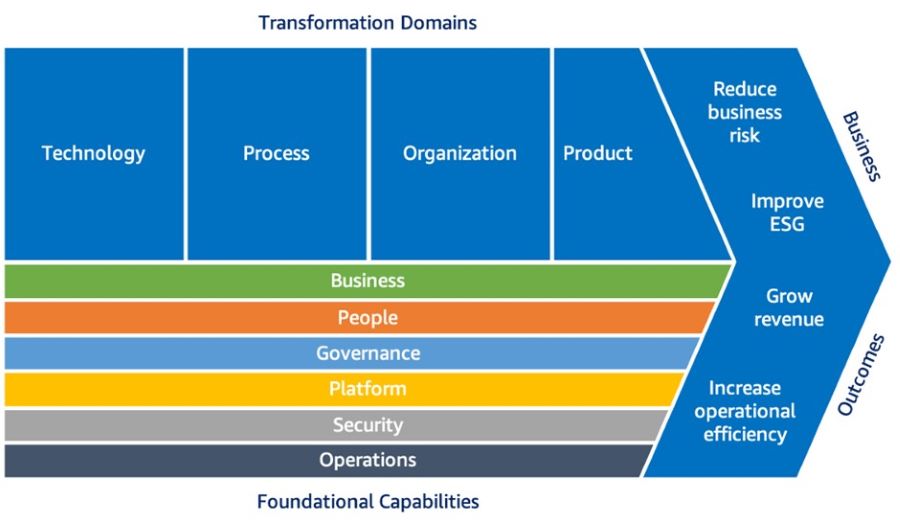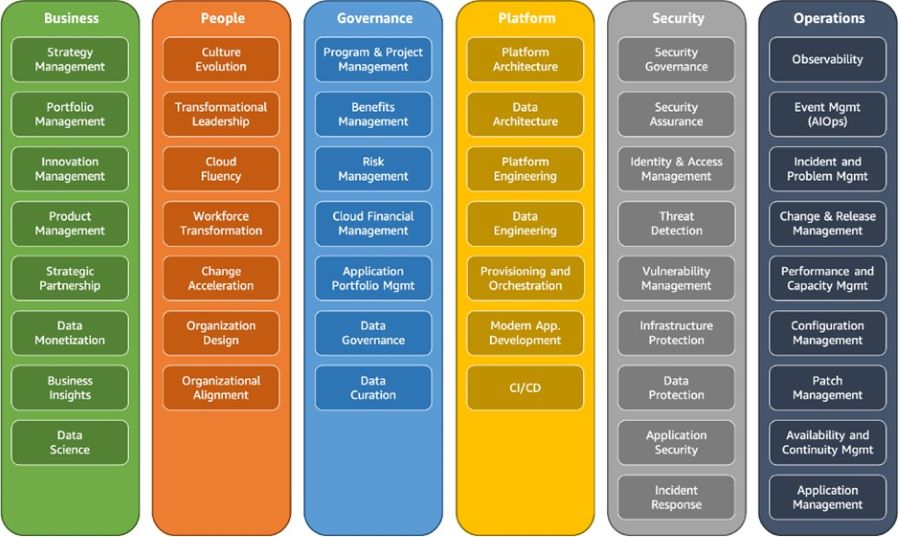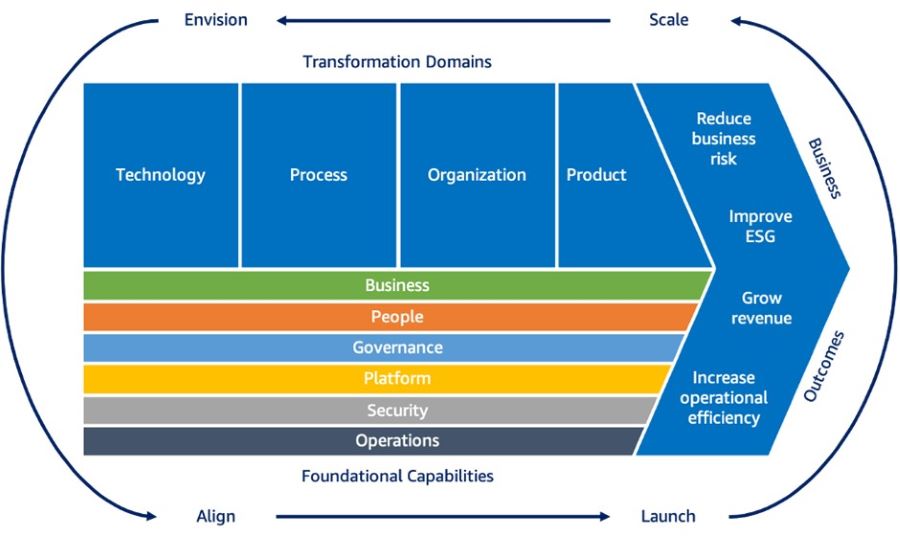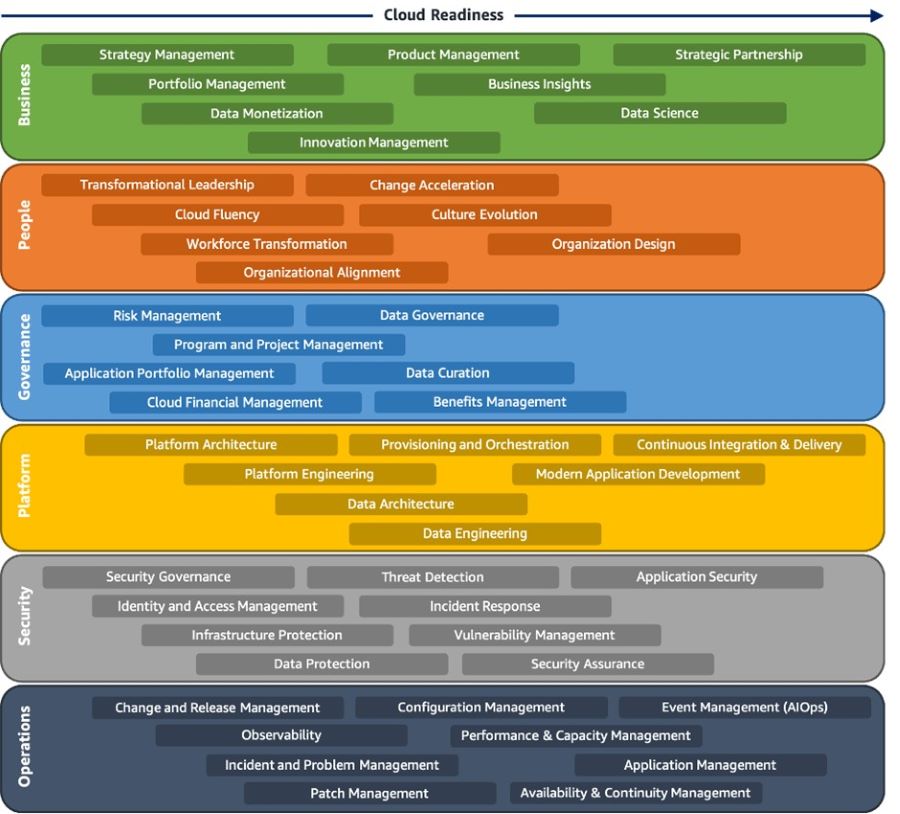|
Cloud adoption frameworks, like the AWS Cloud Adoption Framework (AWS CAF), provide guidance based on best practices and industry experience to help organizations navigate their digital transformation journeys and achieve desired business outcomes using cloud technologies. The AWS CAF serves as a comprehensive resource for organizations looking to digitally transform their operations through the innovative use of AWS. It offers a structured approach to identify and prioritize transformation opportunities, assess cloud readiness, and develop a transformation roadmap that can be iteratively refined over time. Unlocking Business Value through Cloud-Powered Digital TransformationCloud-powered digital transformation involves a series of interconnected processes and capabilities that drive organizational change and deliver business value. By leveraging cloud technologies, organizations can undergo technological, process, organizational, and product transformations, leading to various business outcomes. These outcomes encompass reducing business risks, enhancing environmental, social, and governance (ESG) performance, as well as increasing revenue and operational efficiency. Cloud adoption frameworks, like the AWS CAF, provide organizations with a roadmap and set of foundational capabilities to accelerate their digital transformation journeys and achieve these desired outcomes. By employing a comprehensive framework like the AWS CAF, organizations can effectively navigate the path to cloud-powered digital transformation and harness the full potential of cloud technologies to drive business success. Cloud transformation value chain Leveraging Cloud for Technological Transformation When it comes to technological transformation, the focus lies in utilizing the power of the cloud to migrate and modernize legacy infrastructure, applications, and data and analytics platforms. According to Cloud Value Benchmarking, migrating from on-premises to AWS can yield significant benefits. This includes a remarkable 27% reduction in cost per user, a 58% increase in VMs managed per admin, a 57% decrease in downtime, and a 34% decrease in security events. These statistics showcase the potential for cost savings and improved operational efficiency through cloud migration. Driving Process Transformation through Digitization and Automation Process transformation centers around digitizing, automating, and optimizing your business operations. This entails embracing new data and analytics platforms to generate actionable insights and leveraging machine learning (ML) to enhance various aspects of your organization. By employing ML, you can improve customer service experiences, boost employee productivity and decision-making, enhance business forecasting, strengthen fraud detection and prevention, streamline industrial operations, and more. This process optimization can lead to increased operational efficiency, reduced operating costs, and improved experiences for both employees and customers. Reimagining Organizational Dynamics for Transformation Organizational transformation involves reimagining your operating model and how your business and technology teams collaborate to create customer value and fulfill your strategic goals. A key aspect of this transformation is organizing your teams around products and value streams. By adopting agile methods and encouraging rapid iteration and evolution, you can foster a more responsive and customer-centric environment. This shift in organizational dynamics allows for greater adaptability and agility in meeting customer demands and market changes. Revamping Products and Revenue Models for Growth Product transformation revolves around reimagining your business model by developing new value propositions, including products and services, and exploring innovative revenue models. This approach enables you to reach new customers and tap into previously untapped market segments. According to Cloud Value Benchmarking, adopting AWS can lead to a 37% reduction in time-to-market for new features and applications, a significant 342% increase in code deployment frequency, and a notable 38% reduction in the time required to deploy new code. These statistics highlight the potential for accelerated innovation and market responsiveness through the adoption of AWS. By embracing the various facets of transformation outlined above—technological, process, organizational, and product—you can propel your organization forward, leveraging the cloud to unlock new possibilities and achieve your desired business outcomes. Foundational CapabilitiesTo enable each transformation domain discussed earlier, a set of foundational capabilities is essential. These capabilities serve as the building blocks for achieving desired outcomes. The figure below illustrates these foundational capabilities. In simple terms, a capability refers to an organizational ability to utilize processes and resources, including people, technology, and other assets, to accomplish specific goals. In the context of AWS Cloud Adoption Framework (AWS CAF), these capabilities offer best practice guidance to enhance your cloud readiness, ensuring effective utilization of the cloud for digital transformation. AWS CAF organizes these capabilities into six perspectives: Business, People, Governance, Platform, Security, and Operations. Each perspective encompasses a collection of capabilities that are owned or managed by stakeholders associated with your cloud transformation journey. AWS CAF perspectives and foundational capabilities Business Perspective The Business perspective aims to ensure that your cloud investments align with your digital transformation goals and contribute to overall business outcomes. Key stakeholders in this perspective include the CEO, CFO, COO, CIO, and CTO. Their involvement is crucial in leveraging cloud technologies to drive strategic initiatives and achieve desired business results. People Perspective The People perspective acts as a bridge between technology and business, accelerating the cloud journey and facilitating a culture of continuous growth and learning. It focuses on aspects such as organizational culture, structure, leadership, and workforce development. Key stakeholders in this perspective include the CIO, COO, CTO, cloud director, and cross-functional leaders across the organization. Governance Perspective The Governance perspective plays a vital role in orchestrating your cloud initiatives while maximizing organizational benefits and mitigating transformation-related risks. It involves stakeholders such as the chief transformation officer, CIO, CTO, CFO, CDO, and CRO. Their involvement ensures that proper governance mechanisms are in place to guide decision-making, compliance, and risk management throughout the cloud transformation journey. Platform Perspective The Platform perspective focuses on building an enterprise-grade, scalable, hybrid cloud platform. It encompasses modernizing existing workloads and implementing new cloud-native solutions. Key stakeholders in this perspective include the CTO, technology leaders, architects, and engineers who play a crucial role in designing and implementing an effective cloud platform. Security Persepctive The Security perspective is dedicated to achieving the confidentiality, integrity, and availability of data and cloud workloads. It involves stakeholders such as the CISO, CCO, internal audit leaders, and security architects and engineers. Their expertise ensures that robust security measures are in place to protect data and maintain compliance with relevant regulations. Operations Persepctive The Operations perspective focuses on delivering cloud services that meet the needs of your business. It involves stakeholders such as infrastructure and operations leaders, site reliability engineers, and IT service managers. Their efforts ensure the smooth functioning of cloud services and efficient management of operational processes. By understanding and effectively leveraging these foundational capabilities across the various perspectives, organizations can drive successful cloud-powered transformations and achieve their desired business outcomes. Embarking on Your Cloud Transformation JourneyEvery organization's journey to the cloud is unique. To ensure the success of your transformation, it is essential to have a clear vision of your desired target state, evaluate your cloud readiness, and embrace an agile approach to bridge any gaps that may arise. By adopting an incremental and iterative strategy, you can quickly demonstrate value while avoiding the need to make extensive predictions. This iterative approach allows you to maintain momentum and adapt your roadmap based on the valuable insights gained through experience. The AWS Cloud Adoption Framework (AWS CAF) recommends four distinct phases for your cloud transformation journey, as illustrated below. Cloud transformation journey Phase 1: Envision During the Envision phase, the focus is on showcasing how the cloud can accelerate your business outcomes. This involves identifying and prioritizing transformation opportunities across the four transformation domains in alignment with your strategic business objectives. By associating your transformation initiatives with key stakeholders who possess the influence and ability to drive change, and by emphasizing measurable business outcomes, you can effectively demonstrate the value of your transformation journey as you progress. Phase 2: Align The Align phase revolves around identifying capability gaps across the six perspectives of the AWS CAF. It involves recognizing cross-organizational dependencies and addressing stakeholder concerns and challenges. This phase helps you develop strategies to enhance your cloud readiness, ensure stakeholder alignment, and facilitate relevant organizational change management activities. By focusing on these foundational aspects, you establish a solid footing for your cloud transformation journey. Phase 3: Launch The Launch phase emphasizes delivering pilot initiatives in a production environment to showcase incremental business value. These pilots should be carefully selected for their significant impact and potential to influence future directions. Learning from these pilot projects allows you to make necessary adjustments before scaling up to full production, ensuring a smoother transition and minimizing risks. Phase 4: Scale The Scale phase is all about expanding production pilots and fully realizing the business benefits associated with your cloud investments. The goal is to extend the demonstrated value to the desired scale and ensure its sustainability. By gradually increasing the scope of your cloud initiatives and leveraging the lessons learned along the way, you can effectively amplify the positive impact on your organization. It's important to note that you don't have to tackle all the foundational capabilities at once. As you progress through your cloud transformation journey, you can evolve these capabilities and improve your cloud readiness accordingly. Consider tailoring the suggested sequence depicted in the figure to suit your organization's specific needs and priorities. This flexibility allows you to navigate your transformation journey with agility and customization, ensuring a successful transition to the cloud. Evolution of AWS CAF perspectives and foundational capabilities SummaryIn conclusion, embarking on a cloud transformation journey is a significant undertaking for any organization. By leveraging the AWS Cloud Adoption Framework (AWS CAF) and following the iterative and incremental approach, you can successfully navigate this journey and unlock the full potential of the cloud. Envisioning your desired target state, aligning capabilities, launching pilot initiatives, and scaling up to achieve business value are essential phases that contribute to a smooth and impactful transformation. As you progress through your cloud transformation, it's crucial to consider the unique needs and priorities of your organization. Tailoring the foundational capabilities and sequence of activities outlined in the AWS CAF to your specific requirements will allow for a more customized and effective transformation. Remember, this journey is not a one-size-fits-all approach, but rather a dynamic process that evolves with your organization's goals and aspirations. Building upon the foundations discussed in this article, we will now delve into a series of articles that explore each of the six AWS CAF perspectives or pillars. These perspectives - Business, People, Governance, Platform, Security, and Operations - play vital roles in shaping your cloud transformation and ensuring its success. Stay tuned for our upcoming series, where we will provide in-depth insights into each AWS CAF perspective. From aligning cloud investments with strategic business objectives to establishing robust security measures, we will guide you through the intricacies of these perspectives and equip you with the knowledge to make informed decisions along your cloud transformation journey.
0 Comments
Leave a Reply. |
AuthorTim Hardwick is a Strategy & Transformation Consultant specialising in Technology Strategy & Enterprise Architecture Archives
June 2023
Categories
All
|
Site powered by Weebly. Managed by iPage






